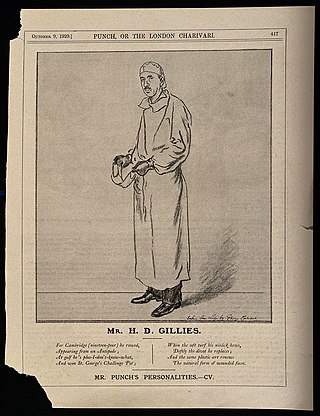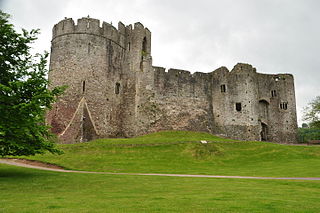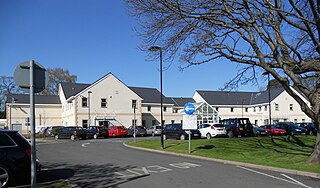
Plastic surgery is a surgical specialty involving the restoration, reconstruction or alteration of the human body. It can be divided into two main categories: reconstructive surgery and cosmetic surgery. Reconstructive surgery includes craniofacial surgery, hand surgery, microsurgery, and the treatment of burns. While reconstructive surgery aims to reconstruct a part of the body or improve its functioning, cosmetic surgery aims at improving the appearance of it.

Chepstow is a town and community in Monmouthshire, Wales, adjoining the border with Gloucestershire, England. It is located on the tidal River Wye, about 2 miles (3 km) above its confluence with the River Severn, and adjoining the western end of the Severn Bridge. It is the easternmost settlement in Wales, situated 16 miles (26 km) east of Newport, 28 miles (45 km) east-northeast of Cardiff, 18 miles (29 km) northwest of Bristol and 110 miles (180 km) west of London.

Sir Harold Delf Gillies was a New Zealand otolaryngologist and father of modern plastic surgery.

Newport is a city and county borough in Wales, situated on the River Usk close to its confluence with the Severn Estuary, 12 mi (19 km) northeast of Cardiff. With a population of 145,700 at the 2011 census, Newport is the third-largest authority with city status in Wales, and seventh most populous overall. Newport became a unitary authority in 1996 and forms part of the Cardiff-Newport metropolitan area. Newport was the site of the last large-scale armed insurrection in Great Britain, the Newport Rising of 1839. The population grew considerably during the 2021 census, rising to 159,587, the largest growth of a unitary authority in Wales.

The University of Texas Medical Branch (UTMB) is a public academic health science center in Galveston, Texas, United States. It is part of the University of Texas System. UTMB includes the oldest medical school in Texas, and has about 11,000 employees. In February 2019, it received an endowment of $560 million.

Sir Archibald Hector McIndoe was a New Zealand plastic surgeon who worked for the Royal Air Force during the Second World War. He improved the treatment and rehabilitation of badly burned aircrew.

Chepstow Castle at Chepstow, Monmouthshire, Wales is the oldest surviving post-Roman stone fortification in Britain. Located above cliffs on the River Wye, construction began in 1067 under the instruction of the Norman Lord William FitzOsbern. Originally known as Striguil, it was the southernmost of a chain of castles built in the Welsh Marches, and with its attached lordship took the name of the adjoining market town in about the 14th century.

The Queen Victoria Hospital (QVH), located in East Grinstead, West Sussex, England is the specialist reconstructive surgery centre for the south east of England, and also provides services at clinics across the region. It has become world-famous for its pioneering burns and plastic surgery. The hospital was named after Queen Victoria. It is managed by the Queen Victoria Hospital NHS Foundation Trust.

Morriston Hospital is a 750-bed hospital located in Cwmrhydyceirw near Morriston in Swansea, Wales. It is managed by Swansea Bay University Health Board. Alongside its role as a district general hospital, Morriston is a teaching hospital for medical students of Swansea University Medical School.
Chepstow Racecourse is a thoroughbred horse racing course located just north of the town of Chepstow in Monmouthshire, Wales, near the southern end of the Wye Valley and close to the border with England. It is one of 16 racecourses operated by the Arena Racing Company and is home of the richest race in Wales, the Coral Welsh Grand National.

Monnow Vale Integrated Health and Social Care Facility is a hospital at Drybridge Park in Monmouth, Wales. It is managed by the Aneurin Bevan University Health Board.

Chepstow Community Hospital is a community hospital located on the east side of St Lawrence Road in Chepstow, Monmouthshire, Wales. It is managed by the Aneurin Bevan University Health Board.
Bangour General Hospital was a hospital just west of the village of Dechmont, West Lothian, Scotland. It had its origins during the Second World War when hospital bed numbers in Scotland were greatly expanded to deal with the anticipated increase in civilian and military war casualties. The Emergency Hospital Service (Scotland) scheme resulted in seven new hospitals being built, while at Bangour Village Hospital in West Lothian an annexe of five ward blocks was built and this developed into Bangour General Hospital after the war. This hospital served the population of West Lothian as a general hospital and also included a maxillo-facial unit serving the Lothian region and a burns and plastic surgery unit serving much of east Scotland, the Borders and the Highland region. The hospital services were transferred to the newly built St John's Hospital at Livingston during 1989–90, and Bangour General Hospital closed in 1990 and was subsequently demolished.

Bulwark is a predominantly residential area of Chepstow, Monmouthshire, Wales, largely developed during the twentieth century. The area is so named because of its Iron Age fort, which is now maintained as a public open space. Substantial development in the area began during the First World War, with housing being provided for the military and civilian workforce brought to the area for the National Shipyard no.1 at Chepstow.

Fiona Melanie Wood is an English-born Australian plastic surgeon working in Perth, Western Australia. She is the director of the Royal Perth Hospital burns unit and the Western Australia Burns Service. In addition, Wood is also a clinical professor with the School of Paediatrics and Child Health at the University of Western Australia and director of the Fiona Wood Foundation.

Alexander Burns Wallace (1906–1974) was a Scottish plastic surgeon. He was a founding member and president (1951) of the British Association of Plastic Surgeons, and the first editor of the British Journal of Plastic Surgery. In authorship he appears as A. B. Wallace.

Monmouthshire is a county and principal area of Wales. It borders Torfaen and Newport to the west; Herefordshire and Gloucestershire to the east; and Powys to the north. The largest town is Abergavenny, with the other major towns being Chepstow, Monmouth, and Usk. The county is 850 km2 in extent, with a population of 95,200 as of 2020. The present county was formed under the Local Government (Wales) Act 1994, which came into effect in 1996, and comprises some sixty percent of the historic county. Between 1974 and 1996, the county was known by the ancient title of Gwent, recalling the medieval Welsh kingdom. In his essay on local government in the fifth and final volume of the Gwent County History, Robert McCloy suggests that the governance of "no county in the United Kingdom in the twentieth century was so transformed as that of Monmouthshire".

David Malcolm Nott is a Welsh consultant surgeon who works mainly in London hospitals as a general and vascular surgeon, but also volunteers to work in disaster and war zones. Having recognised that training others could greatly increase his capacity to help, Nott established the David Nott Foundation, along with his wife Elly, to organise training in emergency surgery for others working in war and disaster zones. He has been honoured for this dangerous work and is now often styled the "Indiana Jones of surgery".
Patrick Wensley Clarkson,, was a plastic surgeon at Guy's Hospital in London, best known for surgery of the hand and the description of "Poland Syndactyly", later termed Poland syndrome.
Ian Fraser Muir MBE, FRCS, FRCSEd was an English plastic surgeon at the West Middlesex Hospital and Mount Vernon Centre for Plastic Surgery. While working there he developed what became known as the 'Muir and Barclay formula' which estimates the volume of fluid replacement required in the initial resuscitation after major burns. In 1969, he relocated to Aberdeen to set up the plastic surgery and burns unit, having been appointed plastic surgeon and senior lecturer in Surgery at the University of Aberdeen. He was elected president of the British Association of Plastic Surgeons
















